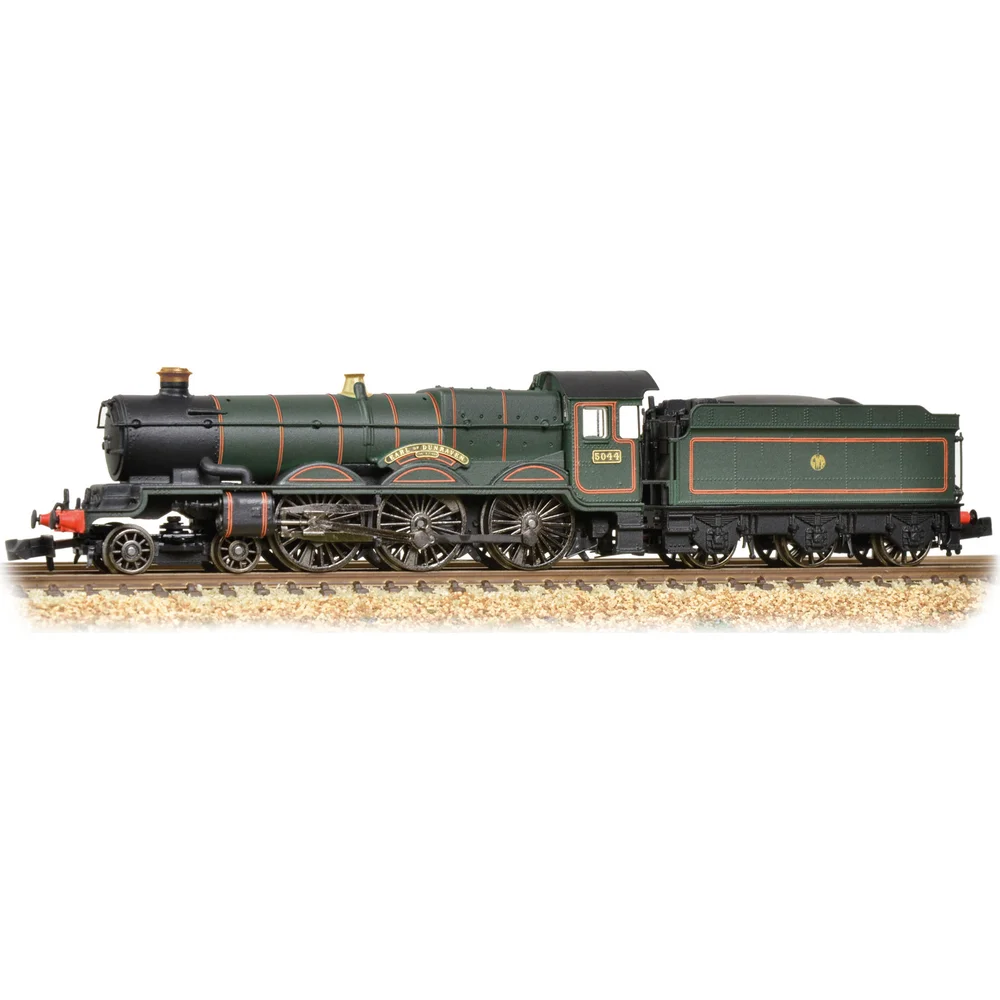Graham Farish 372-030
Great Western Railway 4073 Class 5044 Earl of Dunraven Great Western Railway Lined Green with Shirtbutton
Class & Prototype
- Class: Great Western Railway 4073 Class
- Traction: Steam
- Built: 1923-1950
- Total Built: 171
- Running Number: 5044
- Name: Earl of Dunraven
- Ordered By: Great Western Railway
- Built By: Great Western Railway
- Built At: Swindon
- Built: 03/1936
- Withdrawn: 04/1962
- Length of Service: 26.1 years
- Running Numbers: GWR 5044
- Names: Earl of Dunraven
The GWR 4073 Castle Class represents the pinnacle of Great Western Railway express passenger design, introduced by Charles Collett in 1923. These legendary 4-6-0 locomotives famously outperformed LNER Pacifics in the 1925 exchange trials, proving their superior fuel economy and performance. With 171 built between 1923-1950, they handled premier services like the "Cornish Riviera Express" for over four decades. Eight survive in preservation, with excellent model representations available from Hornby, Graham Farish, and specialist manufacturers. Essential for any authentic GWR layout.
Operator & Livery
- Operator: Great Western Railway
- Livery: Lined Green with Shirtbutton
- Era: 3 - The big 4 – LMS, GWR, LNER & SR
The Great Western Railway (1835-1947) was Britain's most innovative railway company, engineered by Isambard Kingdom Brunel with his revolutionary 7ft ¼in broad gauge system. Known affectionately as "God's Wonderful Railway" and the "Holiday Line," the GWR connected London Paddington with the West Country, Wales, and Birmingham through 3,800 miles of superbly engineered routes.
Renowned for its Brunswick green locomotives, chocolate and cream carriages, and engineering excellence centred at Swindon Works, the GWR pioneered advanced steam technology under chief mechanical engineers Daniel Gooch, George Jackson Churchward, and Charles Collett. The company's legendary locomotive classes—including Castle, King, Hall, and Manor—established performance standards that influenced British locomotive design for decades.
The only "Big Four" railway to retain its original identity through the 1921 grouping, the GWR maintained its distinctive corporate culture until nationalisation in 1947. Today, the company's engineering legacy lives on through extensive preservation efforts, heritage railways, and detailed model railway recreations that celebrate the finest traditions of British steam railway operation.
The GWR Lined Green with Shirtbutton livery marked a significant modernisation of Great Western Railway corporate branding, introduced in 1934 to replace the traditional "GREAT WESTERN" lettering with a distinctive circular "roundel" monogram. This streamlined design featured the company's standard Middle Chrome Green with orange and black lining, distinguished by the iconic 12-inch diameter gilt roundel with black outline positioned centrally on tender and tank sides.
Nicknamed the "Shirtbutton" due to its resemblance to a shirt button, this modernist logo was created from an official Swindon drawing dated July 1934. The first recorded application appeared on 1 June 1934, initially hand-painted before production transfers became available. The roundel's compact design aimed to provide cleaner, more contemporary branding that reflected 1930s modernisation trends across British industry.
Applied to all locomotive classes during this period—including Castle, King, Hall, Grange, and Pannier Tank locomotives—the shirtbutton livery created visual uniformity across the GWR fleet. However, the 12-inch diameter proved somewhat small on larger locomotives like Collett 4000-gallon tenders, where it could appear insignificant. Many locomotives never received the roundel before it was replaced in 1942 with the more prominent twin shield crest design.
Modelling Note: This livery is authentically represented by manufacturers including Rapido, Bachmann, and Hornby, with Fox Transfers offering accurate roundel decals (reference FRH4101) for detailing work. The period represents an important transitional phase in GWR corporate identity evolution.
